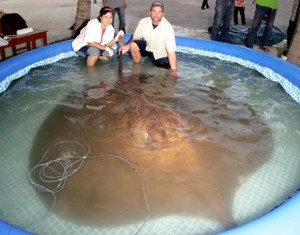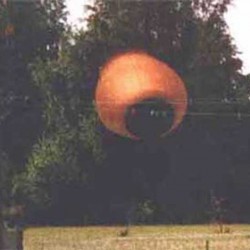Follow US:
American TV nature conservationist Jeff Corwin has caught a giant freshwater stingray and broke the world record for using a rod and line.
The 8ft wide, 14ft long (car sized) stingray weighs around 800lbs (57 stone) and is thought to be the largest freshwater fish ever caught on a line.
[divider]
[youtube]https://www.youtube.com/watch?v=W9QiyxQ96ZU[/youtube]
Jeff Corwin on the mysteries of giant freshwater stingrays
The world record for the largest freshwater fish caught by rod and line has been broken with the catch of this stunning stingray.
The gigantic flat fish that has a lethal barb measured over 8ft in width, 14ft in length and weighed almost 800lbs (57 stones).
It was caught by American TV nature conservationist Jeff Corwin on the Maeklong River in Thailand with the help of fishing guides from UK-based Fishsiam Ltd.
Other giant stingrays have been caught in the past, the one below was caught in Cambodia in April 2008.
[youtube]https://www.youtube.com/watch?v=GMEqMma8Knw[/youtube]
Unknown to science until 1990, the giant freshwater stingray is an elusive creature that inhabits deep rivers in Southeast Asia, Indonesia, Malaysia, and Northern Australia.
[divider]

The giant freshwater stingray (Himantura polylepis, also widely known by the junior synonym H. chaophraya) is a species of stingray in the family Dasyatidae. It is found in large rivers and estuaries in Indochina and Borneo, though historically it may have been more widely distributed in South and Southeast Asia. One of the largest freshwater fishes in the world, this species grows upwards of 1.9 m (6.2 ft) across and may reach 600 kg (1,300 lb) in weight. It has a relatively thin, oval pectoral fin disc that is widest anteriorly, and a sharply pointed snout with a protruding tip. Its tail is thin and whip-like, and lacks fin folds. This species is uniformly grayish brown above and white below; the underside of the pectoral and pelvic fins bear distinctive wide, dark bands on their posterior margins.
Bottom-dwelling in nature, the giant freshwater stingray inhabits sandy or muddy areas and preys on small fishes and invertebrates. Females give live birth to litters of one to four pups, which are sustained to term by maternally produced histotroph (“uterine milk”). This species faces heavy fishing pressure for meat, recreation, and aquarium display, as well as extensive habitat degradation and fragmentation. These forces have resulted in substantial population declines in at least central Thailand and Cambodia. As a result, the International Union for Conservation of Nature (IUCN) has assessed the giant freshwater stingray as Endangered.
Advertisements















